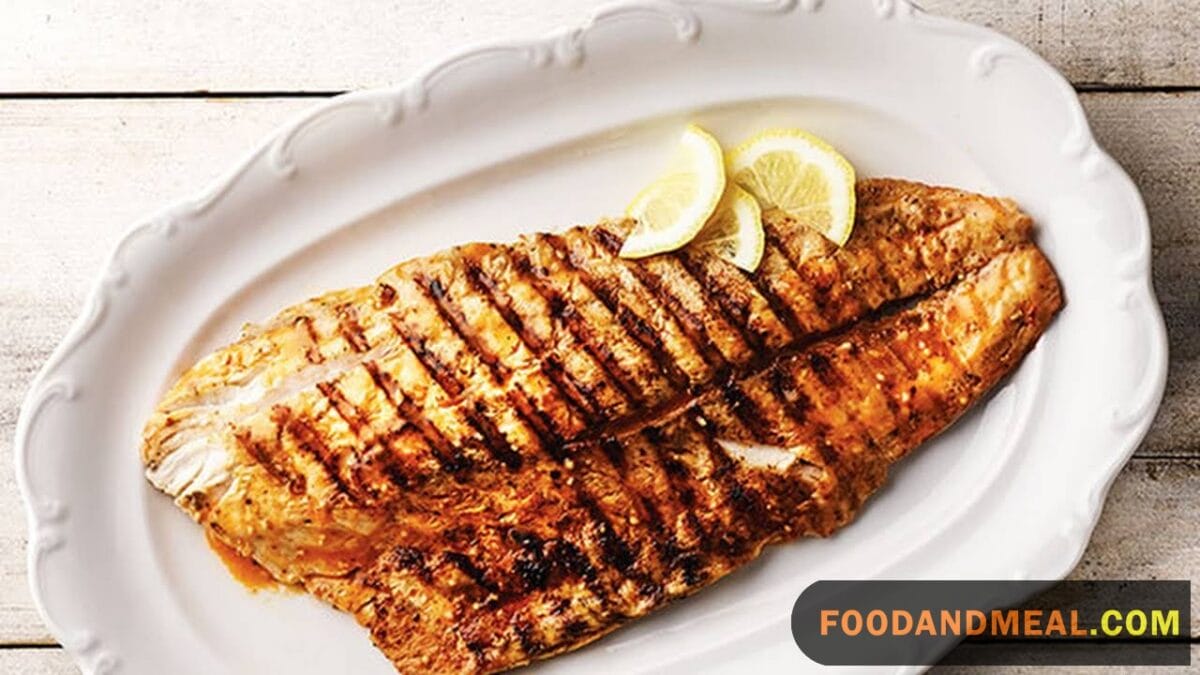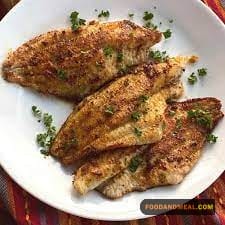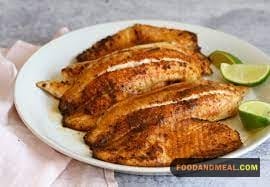As the sun dips below the horizon, casting a warm glow over the bustling kitchen of Food And Meal, I find myself drawn to the comfort and familiarity of a beloved recipe: Redfish fillet. It’s Jaime Inez here, your culinary guide and enthusiast, ready to share with you a dish that holds a special place in my heart and on my table.
There’s something about redfish that speaks to me of home—its firm texture and sweet, nutty flavor reminiscent of countless family gatherings and laughter-filled dinners. It’s a fish that doesn’t need much adornment; its natural beauty and taste shine through with just a few simple ingredients and the right technique.
The desire to make this dish tonight is twofold. Firstly, it’s an homage to my coastal roots, a nod to the fishermen who brave the early mornings to bring us the freshest catch. Secondly, it’s a celebration of simplicity in cooking, a testament to the fact that a few well-chosen elements can create a meal that’s both soul-satisfying and elegant.
In this blog post, I’m excited to take you through the steps of preparing a redfish fillet that’s sure to impress your guests and please your palate. We’ll talk about the importance of sourcing sustainably caught fish, the joy of seasoning with a light hand, and the art of cooking it to perfection. Whether you’re a seasoned chef or a curious novice, this recipe is designed to inspire confidence and creativity in your kitchen.
Redfish fillet Recipe


Redfish fillet
Equipment
Ingredients
- 400 g redfish fillet frozen
- Lemon juice
- Salt
- 1 tbsp oil
- 1 teaspoon paprika powder noble sweet
- 4 slices of pineapple
- 1 teaspoon butter
Instructions
- Let the fish thaw.
- Drizzle with lemon juice and rub with salt.
- Mix the oil with the paprika powder and salt.
- Turn on the contact grill.
- Place the fillets in the contact grill and cook for about 5 minutes.
- Brush with the paprika oil and cook for another 5 minutes.
- Put the butter in a pan and fry the pineapple slices in it, serve with the fish.
Video
Nutrition
© Food And Meal
This website provides approximate nutrition information for convenience and as a courtesy only. Nutrition data is gathered primarily from the Spoonacular Database, whenever available, or otherwise other online calculators.
How to make Redfish fillet using oven

When I set out to make redfish fillet in the oven, I am reminded of the serene waters from which this beautiful fish hails. There is a deep respect for the ingredient, a desire to honor its journey from ocean to plate. I select a fillet that is fresh and glistening, its flesh firm and promising. The fillet speaks of the sea, and I listen, choosing to enhance it with seasonings that will accentuate rather than overpower its natural taste.
The seasoning process is a thoughtful one. A sprinkle of sea salt, a crack of black pepper, perhaps a whisper of smoked paprika to complement the redfish’s inherent sweetness. A drizzle of olive oil for moisture and a slice of lemon placed atop the fillet add a bright note, hinting at the citrusy undertones that will emerge once baked.
As the oven preheats, there is a moment of anticipation. I take this time to reflect on the simplicity of the dish, the beauty in its minimalism. The redfish fillet, now seasoned, is placed on a lined baking sheet or in a lightly oiled baking dish, ready to be transformed by the oven’s embrace.
Baking the fillet requires patience, a virtue in the kitchen. The oven door closes, and the magic begins. The heat works its way through the fillet, cooking it evenly and enveloping the kitchen in a warm, inviting aroma. It’s a comforting process, watching the transformation occur behind the glass, knowing that soon, a delectable meal will be ready to enjoy.
Once the redfish fillet flakes easily with a fork, it’s time to remove it from the oven. There’s a sense of accomplishment in seeing the perfectly cooked fish, its edges slightly golden, its interior moist and flaky. The lemon has done its work, infusing the fillet with a subtle zestiness that elevates the dish.
Serving the redfish fillet is a moment of pride. It’s a dish that doesn’t boast with complexity but rather whispers of home, of the sea, of a love for cooking that is pure and unadorned. The fillet, now resting on the plate, is a canvas for personal expression—perhaps garnished with fresh herbs or accompanied by a side that complements its flavors.
Tips for making Redfish fillet

Cooking tips
One of the first tips I would share is the importance of selecting a high-quality fillet. Look for redfish that has a vibrant color and a fresh smell, indicative of its freshness. The texture should be firm to the touch, suggesting that the fish is at its peak quality. Sourcing sustainably caught redfish is also a consideration that not only affects the quality of your dish but also contributes positively to environmental conservation efforts.
When it comes to seasoning, simplicity is key. Redfish has a distinct taste that should be complemented, not masked. A light sprinkle of sea salt and freshly ground black pepper can often be enough. For those who wish to explore further, a hint of smoked paprika or a brush of garlic-infused olive oil can add a subtle depth of flavor without overwhelming the fish.
The method of cooking is crucial. Whether you’re grilling, pan-searing, or baking, it’s important to preheat your cooking surface to ensure a good sear and even cooking. If grilling or pan-searing, make sure the skin side goes down first; this not only helps to crisp the skin, adding texture and flavor, but also protects the delicate flesh from the direct heat. When baking, a moderate oven temperature will cook the fillet through without drying it out.
Another tip is to be mindful of cooking times. Redfish fillets can vary in thickness, which will affect how long they need to cook. As a general rule, a few minutes per side on a hot grill or skillet, or 10-15 minutes in a 400°F (200°C) oven should suffice, but always check for doneness by ensuring the flesh flakes easily with a fork.
Resting the fish after cooking is a step that should not be overlooked. It allows the juices to redistribute, ensuring that each bite is moist and flavorful. A rest of about five minutes should do the trick.
Finally, consider the presentation. Eating is a multi-sensory experience, and the visual aspect of a dish can greatly enhance the enjoyment of a meal. Garnish the fillet with a sprig of fresh herbs or a slice of lemon for a pop of color and a hint of additional flavor.
Serving Suggestions

Given the list provided, here are some curated serving suggestions that would harmonize with the redfish fillet:
- Miso Soup: Starting the meal with a light miso soup can prepare the palate for the main course. The umami-rich broth is soothing and provides a gentle contrast to the forthcoming flavors of the redfish.
- Daikon Salad: A crisp daikon salad, possibly seasoned with a light vinaigrette or ponzu sauce, offers a refreshing side that can cut through the richness of the fish.
- Rice Milk or Coconut Milk: If the redfish is prepared with spicy or bold seasonings, a glass of rice milk or coconut milk can provide a cooling balance to the meal.
- Soy Milk: For those who enjoy a creamier drink with their meal, soy milk can be a good option. Its neutral taste does not overpower the flavors of the fish.
- Negi Oil: Drizzling the redfish with negi oil (green onion oil) before serving can add a subtle onion flavor that enhances the fish without dominating the dish.
- Oyakodon: Although traditionally made with chicken, an adaptation using redfish could be interesting. The fish could be simmered with onions, soy sauce, and mirin, then served over rice with a softly set egg.
- Mentsuyu: This versatile noodle soup base made from soy sauce, mirin, and dashi can double as a dipping sauce for the redfish if it’s prepared in a more minimalist style, such as grilled or steamed.
- Katsudon: While katsudon is typically a pork dish, creating a version with a breaded and fried redfish fillet, topped with egg and onions over rice, could be a delightful twist.
- Yaki Udon: Stir-fried udon noodles with vegetables would make a hearty and satisfying side dish. The chewy texture of the noodles and the savory flavors would pair well with the redfish.
- Miso Salmon: Although not listed, a similar preparation method could be applied to the redfish. Marinating the fillet in a miso-based sauce before grilling or baking could infuse it with a deep, complex flavor.
Top 5 FAQs about redfish fillet
- What is the best way to cook redfish fillets? The best cooking method can depend on personal preference and the desired outcome. Redfish fillets are versatile and can be prepared in multiple ways, including grilling, baking, broiling, or pan-searing. The firm texture holds up well to different cooking techniques, and the mild flavor pairs nicely with a variety of seasonings and sauces.
- Are redfish fillets healthy? Redfish fillets are considered a good source of protein and contain omega-3 fatty acids, which are beneficial for heart health. They are generally low in mercury and can be a healthy addition to one’s diet when consumed in moderation. However, as with any seafood, it’s important to consider the source and ensure it’s sustainably caught.
- How do you know when redfish fillets are done cooking? The fillets should be cooked until they reach an internal temperature of 145°F (63°C) at the thickest part, which ensures they are safe to eat. The flesh will become opaque and flake easily with a fork when done. Overcooking can dry out the fish, so it’s crucial to monitor the cooking process closely.
- Can redfish fillets be cooked from frozen? While it’s generally recommended to thaw fish before cooking to ensure even cooking and optimal texture, redfish fillets can be cooked from frozen if necessary. The cooking time will need to be increased by approximately 50%, and care should be taken to avoid overcooking the exterior before the interior is fully cooked.
- What are some good seasonings or marinades for redfish fillets? Redfish fillets have a mild, sweet flavor that pairs well with a variety of seasonings. Classic combinations include Cajun or Creole spices, lemon and herbs, or a simple salt and pepper seasoning. Marinades with citrus, garlic, and herbs can also enhance the flavor without overpowering the natural taste of the fish.
Conclusion

In concluding thoughts about redfish fillet, it’s important to recognize the versatility and rich flavor that this fish brings to the table. Redfish, also known as red drum, has a firm texture and a sweet, nutty taste that makes it a favorite among seafood lovers. Its ability to stand up to bold seasonings and various cooking methods—from grilling and broiling to sautéing and baking—makes it a highly adaptable ingredient for a multitude of recipes.
The fillet itself, when cooked properly, offers a satisfying mouthfeel with each bite, flaking beautifully under the fork, yet retaining a moistness that speaks to its quality and freshness. The skin, when left on, can be crisped to add another layer of texture and flavor, enhancing the overall dining experience.
From an emotional standpoint, preparing and enjoying a redfish fillet can evoke a sense of connection to the ocean’s bounty. There’s a certain gratification that comes from cooking such a robust fish, knowing that it can be sourced sustainably and can contribute to a healthy diet rich in omega-3 fatty acids.
Moreover, the act of cooking redfish—or any fish for that matter—is often intertwined with personal stories and cultural traditions. Whether it’s a family recipe passed down through generations or an innovative creation inspired by modern culinary trends, redfish fillet serves as a canvas for expression.
- Cooking Like A Pro
- Author Name : Jaime Inez
- Address: Times Street, West Triangle, 1103, Quezon City, Metro Manila, Philippines
- Phone: 96-2-4108596
- Email: Contact@cookinglikeapro.net

